Expectancy Theory Analysis: Student Motivation and Performance
VerifiedAdded on 2023/01/19
|9
|2622
|64
Essay
AI Summary
This essay delves into the application of expectancy theory in the context of student motivation and academic performance within a university setting. The essay begins by introducing expectancy theory as a framework that explains how students' motivation is influenced by their beliefs about effort, performance, and rewards (valence, instrumentality, and expectancy). The essay then explores how universities can leverage this theory to enhance teaching quality, student engagement, and overall academic achievement. Several research studies are cited to support the arguments, including those examining the impact of peer assessment, group work, and value-reappraisal interventions on student motivation. The essay highlights the importance of setting clear goals, providing positive reinforcement, and fostering a supportive learning environment to enhance student performance and satisfaction. The conclusion emphasizes the role of expectancy theory in understanding and promoting student motivation, with personal reflections on the application of this theory to individual learning experiences.
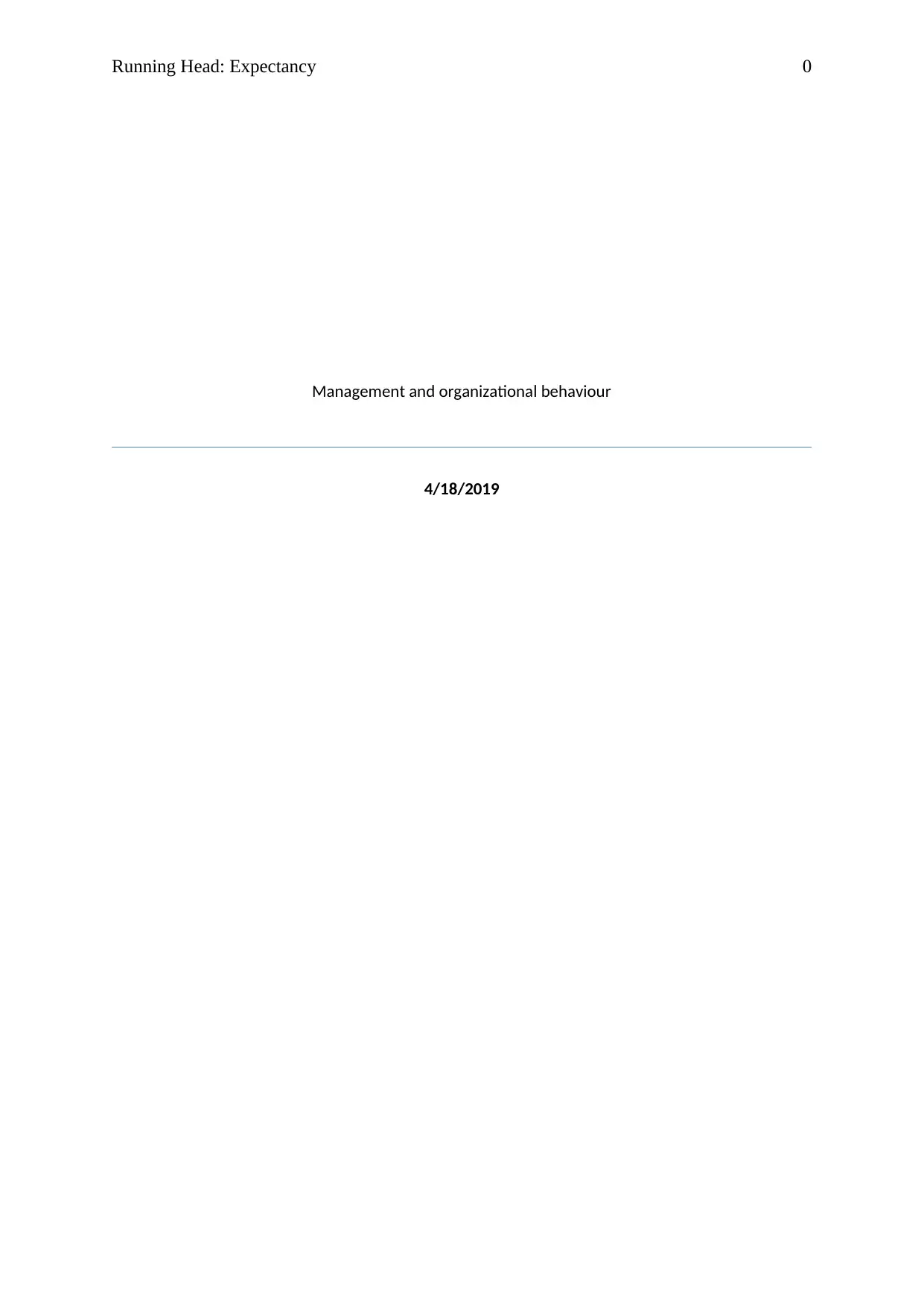
Running Head: Expectancy 0
Management and organizational behaviour
4/18/2019
Management and organizational behaviour
4/18/2019
Paraphrase This Document
Need a fresh take? Get an instant paraphrase of this document with our AI Paraphraser
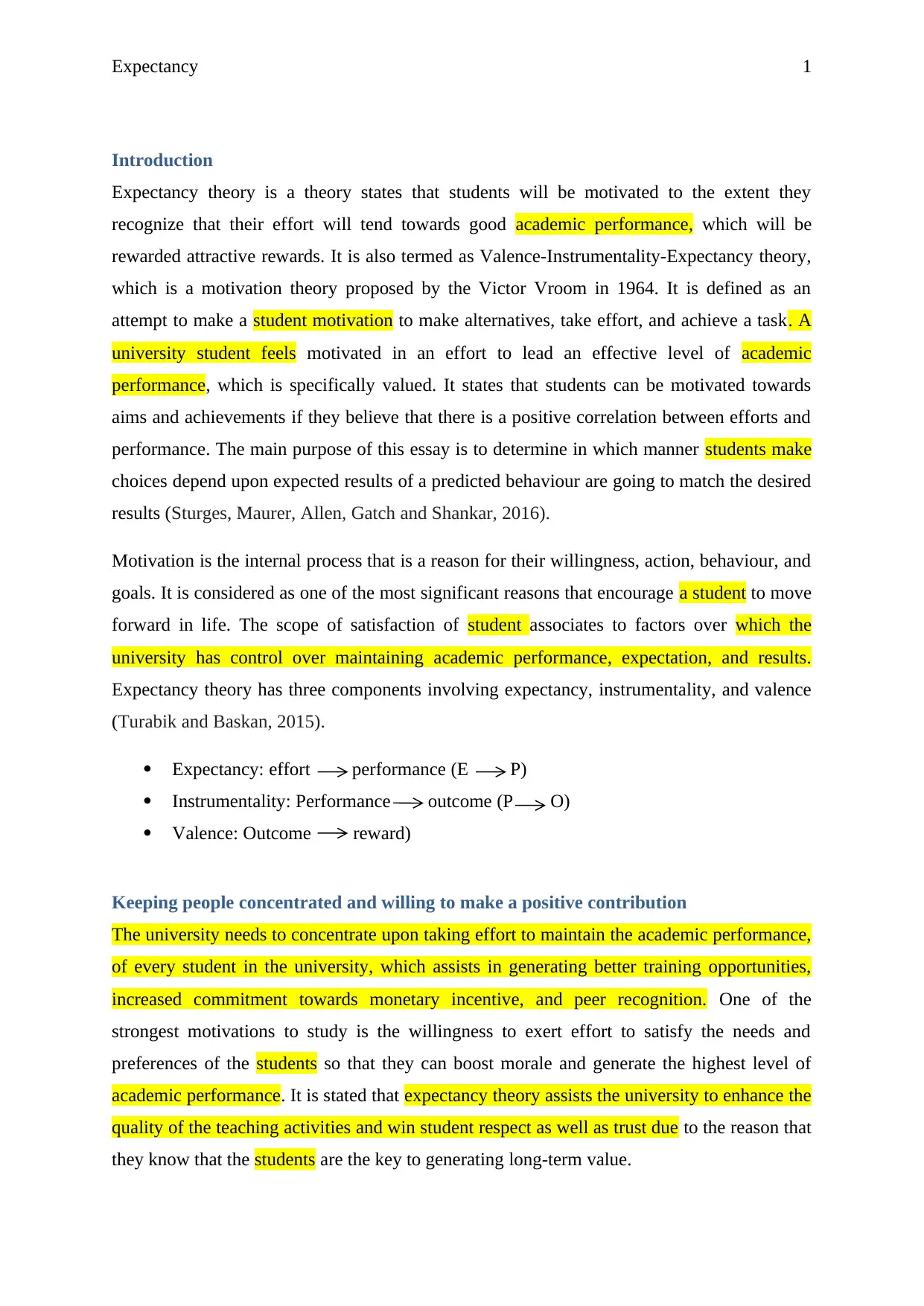
Expectancy 1
Introduction
Expectancy theory is a theory states that students will be motivated to the extent they
recognize that their effort will tend towards good academic performance, which will be
rewarded attractive rewards. It is also termed as Valence-Instrumentality-Expectancy theory,
which is a motivation theory proposed by the Victor Vroom in 1964. It is defined as an
attempt to make a student motivation to make alternatives, take effort, and achieve a task. A
university student feels motivated in an effort to lead an effective level of academic
performance, which is specifically valued. It states that students can be motivated towards
aims and achievements if they believe that there is a positive correlation between efforts and
performance. The main purpose of this essay is to determine in which manner students make
choices depend upon expected results of a predicted behaviour are going to match the desired
results (Sturges, Maurer, Allen, Gatch and Shankar, 2016).
Motivation is the internal process that is a reason for their willingness, action, behaviour, and
goals. It is considered as one of the most significant reasons that encourage a student to move
forward in life. The scope of satisfaction of student associates to factors over which the
university has control over maintaining academic performance, expectation, and results.
Expectancy theory has three components involving expectancy, instrumentality, and valence
(Turabik and Baskan, 2015).
Expectancy: effort performance (E P)
Instrumentality: Performance outcome (P O)
Valence: Outcome reward)
Keeping people concentrated and willing to make a positive contribution
The university needs to concentrate upon taking effort to maintain the academic performance,
of every student in the university, which assists in generating better training opportunities,
increased commitment towards monetary incentive, and peer recognition. One of the
strongest motivations to study is the willingness to exert effort to satisfy the needs and
preferences of the students so that they can boost morale and generate the highest level of
academic performance. It is stated that expectancy theory assists the university to enhance the
quality of the teaching activities and win student respect as well as trust due to the reason that
they know that the students are the key to generating long-term value.
Introduction
Expectancy theory is a theory states that students will be motivated to the extent they
recognize that their effort will tend towards good academic performance, which will be
rewarded attractive rewards. It is also termed as Valence-Instrumentality-Expectancy theory,
which is a motivation theory proposed by the Victor Vroom in 1964. It is defined as an
attempt to make a student motivation to make alternatives, take effort, and achieve a task. A
university student feels motivated in an effort to lead an effective level of academic
performance, which is specifically valued. It states that students can be motivated towards
aims and achievements if they believe that there is a positive correlation between efforts and
performance. The main purpose of this essay is to determine in which manner students make
choices depend upon expected results of a predicted behaviour are going to match the desired
results (Sturges, Maurer, Allen, Gatch and Shankar, 2016).
Motivation is the internal process that is a reason for their willingness, action, behaviour, and
goals. It is considered as one of the most significant reasons that encourage a student to move
forward in life. The scope of satisfaction of student associates to factors over which the
university has control over maintaining academic performance, expectation, and results.
Expectancy theory has three components involving expectancy, instrumentality, and valence
(Turabik and Baskan, 2015).
Expectancy: effort performance (E P)
Instrumentality: Performance outcome (P O)
Valence: Outcome reward)
Keeping people concentrated and willing to make a positive contribution
The university needs to concentrate upon taking effort to maintain the academic performance,
of every student in the university, which assists in generating better training opportunities,
increased commitment towards monetary incentive, and peer recognition. One of the
strongest motivations to study is the willingness to exert effort to satisfy the needs and
preferences of the students so that they can boost morale and generate the highest level of
academic performance. It is stated that expectancy theory assists the university to enhance the
quality of the teaching activities and win student respect as well as trust due to the reason that
they know that the students are the key to generating long-term value.
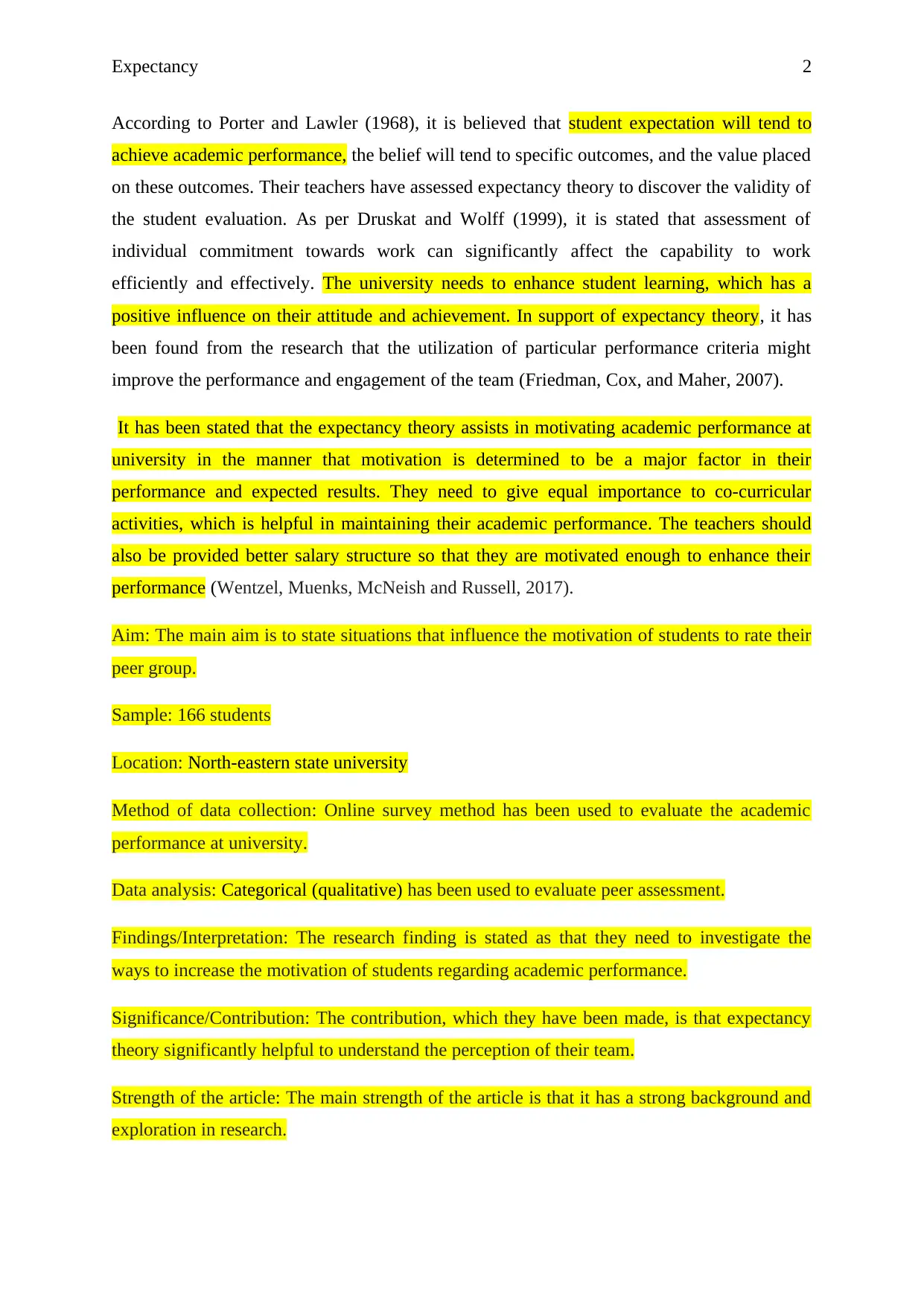
Expectancy 2
According to Porter and Lawler (1968), it is believed that student expectation will tend to
achieve academic performance, the belief will tend to specific outcomes, and the value placed
on these outcomes. Their teachers have assessed expectancy theory to discover the validity of
the student evaluation. As per Druskat and Wolff (1999), it is stated that assessment of
individual commitment towards work can significantly affect the capability to work
efficiently and effectively. The university needs to enhance student learning, which has a
positive influence on their attitude and achievement. In support of expectancy theory, it has
been found from the research that the utilization of particular performance criteria might
improve the performance and engagement of the team (Friedman, Cox, and Maher, 2007).
It has been stated that the expectancy theory assists in motivating academic performance at
university in the manner that motivation is determined to be a major factor in their
performance and expected results. They need to give equal importance to co-curricular
activities, which is helpful in maintaining their academic performance. The teachers should
also be provided better salary structure so that they are motivated enough to enhance their
performance (Wentzel, Muenks, McNeish and Russell, 2017).
Aim: The main aim is to state situations that influence the motivation of students to rate their
peer group.
Sample: 166 students
Location: North-eastern state university
Method of data collection: Online survey method has been used to evaluate the academic
performance at university.
Data analysis: Categorical (qualitative) has been used to evaluate peer assessment.
Findings/Interpretation: The research finding is stated as that they need to investigate the
ways to increase the motivation of students regarding academic performance.
Significance/Contribution: The contribution, which they have been made, is that expectancy
theory significantly helpful to understand the perception of their team.
Strength of the article: The main strength of the article is that it has a strong background and
exploration in research.
According to Porter and Lawler (1968), it is believed that student expectation will tend to
achieve academic performance, the belief will tend to specific outcomes, and the value placed
on these outcomes. Their teachers have assessed expectancy theory to discover the validity of
the student evaluation. As per Druskat and Wolff (1999), it is stated that assessment of
individual commitment towards work can significantly affect the capability to work
efficiently and effectively. The university needs to enhance student learning, which has a
positive influence on their attitude and achievement. In support of expectancy theory, it has
been found from the research that the utilization of particular performance criteria might
improve the performance and engagement of the team (Friedman, Cox, and Maher, 2007).
It has been stated that the expectancy theory assists in motivating academic performance at
university in the manner that motivation is determined to be a major factor in their
performance and expected results. They need to give equal importance to co-curricular
activities, which is helpful in maintaining their academic performance. The teachers should
also be provided better salary structure so that they are motivated enough to enhance their
performance (Wentzel, Muenks, McNeish and Russell, 2017).
Aim: The main aim is to state situations that influence the motivation of students to rate their
peer group.
Sample: 166 students
Location: North-eastern state university
Method of data collection: Online survey method has been used to evaluate the academic
performance at university.
Data analysis: Categorical (qualitative) has been used to evaluate peer assessment.
Findings/Interpretation: The research finding is stated as that they need to investigate the
ways to increase the motivation of students regarding academic performance.
Significance/Contribution: The contribution, which they have been made, is that expectancy
theory significantly helpful to understand the perception of their team.
Strength of the article: The main strength of the article is that it has a strong background and
exploration in research.
⊘ This is a preview!⊘
Do you want full access?
Subscribe today to unlock all pages.

Trusted by 1+ million students worldwide
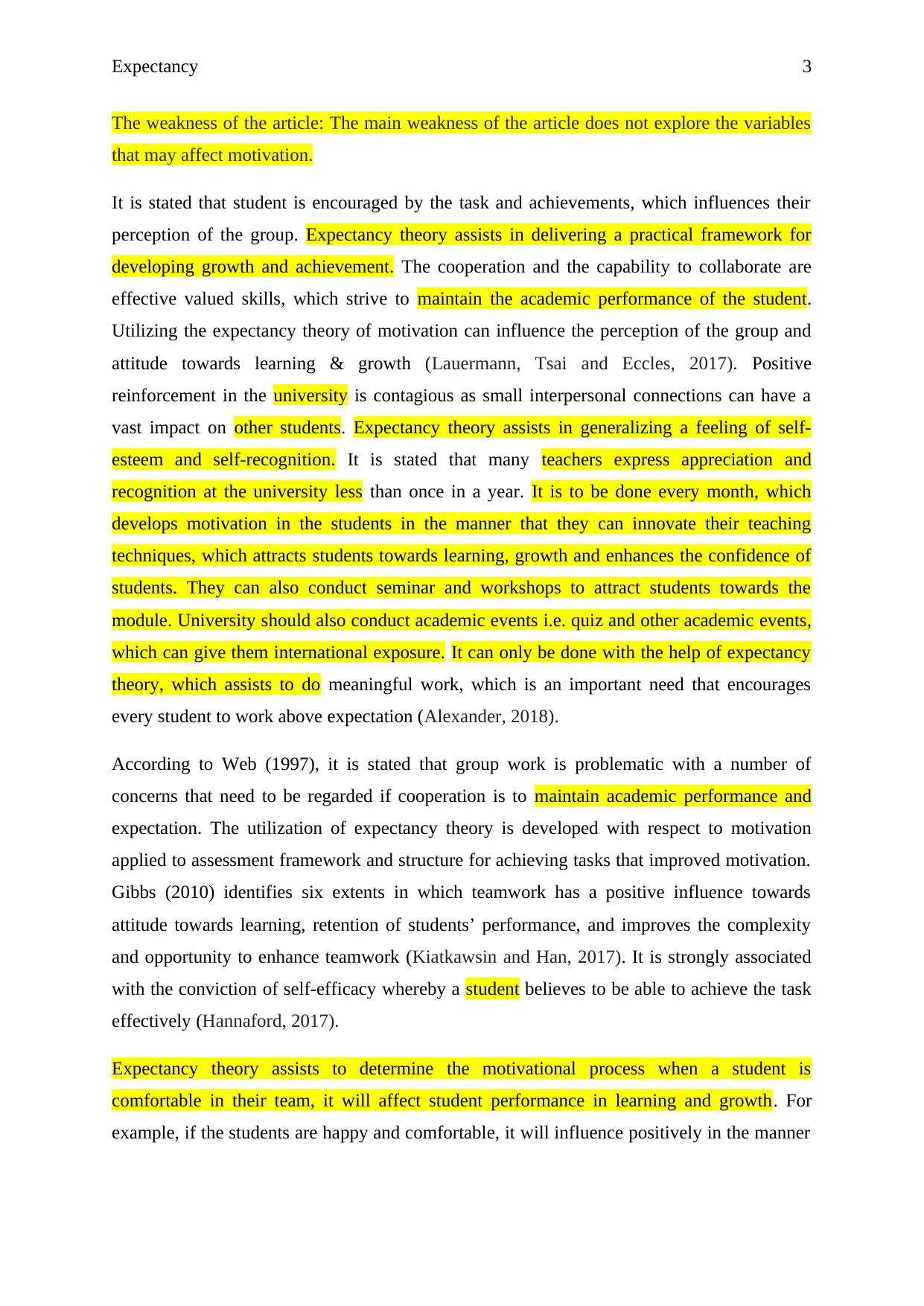
Expectancy 3
The weakness of the article: The main weakness of the article does not explore the variables
that may affect motivation.
It is stated that student is encouraged by the task and achievements, which influences their
perception of the group. Expectancy theory assists in delivering a practical framework for
developing growth and achievement. The cooperation and the capability to collaborate are
effective valued skills, which strive to maintain the academic performance of the student.
Utilizing the expectancy theory of motivation can influence the perception of the group and
attitude towards learning & growth (Lauermann, Tsai and Eccles, 2017). Positive
reinforcement in the university is contagious as small interpersonal connections can have a
vast impact on other students. Expectancy theory assists in generalizing a feeling of self-
esteem and self-recognition. It is stated that many teachers express appreciation and
recognition at the university less than once in a year. It is to be done every month, which
develops motivation in the students in the manner that they can innovate their teaching
techniques, which attracts students towards learning, growth and enhances the confidence of
students. They can also conduct seminar and workshops to attract students towards the
module. University should also conduct academic events i.e. quiz and other academic events,
which can give them international exposure. It can only be done with the help of expectancy
theory, which assists to do meaningful work, which is an important need that encourages
every student to work above expectation (Alexander, 2018).
According to Web (1997), it is stated that group work is problematic with a number of
concerns that need to be regarded if cooperation is to maintain academic performance and
expectation. The utilization of expectancy theory is developed with respect to motivation
applied to assessment framework and structure for achieving tasks that improved motivation.
Gibbs (2010) identifies six extents in which teamwork has a positive influence towards
attitude towards learning, retention of students’ performance, and improves the complexity
and opportunity to enhance teamwork (Kiatkawsin and Han, 2017). It is strongly associated
with the conviction of self-efficacy whereby a student believes to be able to achieve the task
effectively (Hannaford, 2017).
Expectancy theory assists to determine the motivational process when a student is
comfortable in their team, it will affect student performance in learning and growth. For
example, if the students are happy and comfortable, it will influence positively in the manner
The weakness of the article: The main weakness of the article does not explore the variables
that may affect motivation.
It is stated that student is encouraged by the task and achievements, which influences their
perception of the group. Expectancy theory assists in delivering a practical framework for
developing growth and achievement. The cooperation and the capability to collaborate are
effective valued skills, which strive to maintain the academic performance of the student.
Utilizing the expectancy theory of motivation can influence the perception of the group and
attitude towards learning & growth (Lauermann, Tsai and Eccles, 2017). Positive
reinforcement in the university is contagious as small interpersonal connections can have a
vast impact on other students. Expectancy theory assists in generalizing a feeling of self-
esteem and self-recognition. It is stated that many teachers express appreciation and
recognition at the university less than once in a year. It is to be done every month, which
develops motivation in the students in the manner that they can innovate their teaching
techniques, which attracts students towards learning, growth and enhances the confidence of
students. They can also conduct seminar and workshops to attract students towards the
module. University should also conduct academic events i.e. quiz and other academic events,
which can give them international exposure. It can only be done with the help of expectancy
theory, which assists to do meaningful work, which is an important need that encourages
every student to work above expectation (Alexander, 2018).
According to Web (1997), it is stated that group work is problematic with a number of
concerns that need to be regarded if cooperation is to maintain academic performance and
expectation. The utilization of expectancy theory is developed with respect to motivation
applied to assessment framework and structure for achieving tasks that improved motivation.
Gibbs (2010) identifies six extents in which teamwork has a positive influence towards
attitude towards learning, retention of students’ performance, and improves the complexity
and opportunity to enhance teamwork (Kiatkawsin and Han, 2017). It is strongly associated
with the conviction of self-efficacy whereby a student believes to be able to achieve the task
effectively (Hannaford, 2017).
Expectancy theory assists to determine the motivational process when a student is
comfortable in their team, it will affect student performance in learning and growth. For
example, if the students are happy and comfortable, it will influence positively in the manner
Paraphrase This Document
Need a fresh take? Get an instant paraphrase of this document with our AI Paraphraser
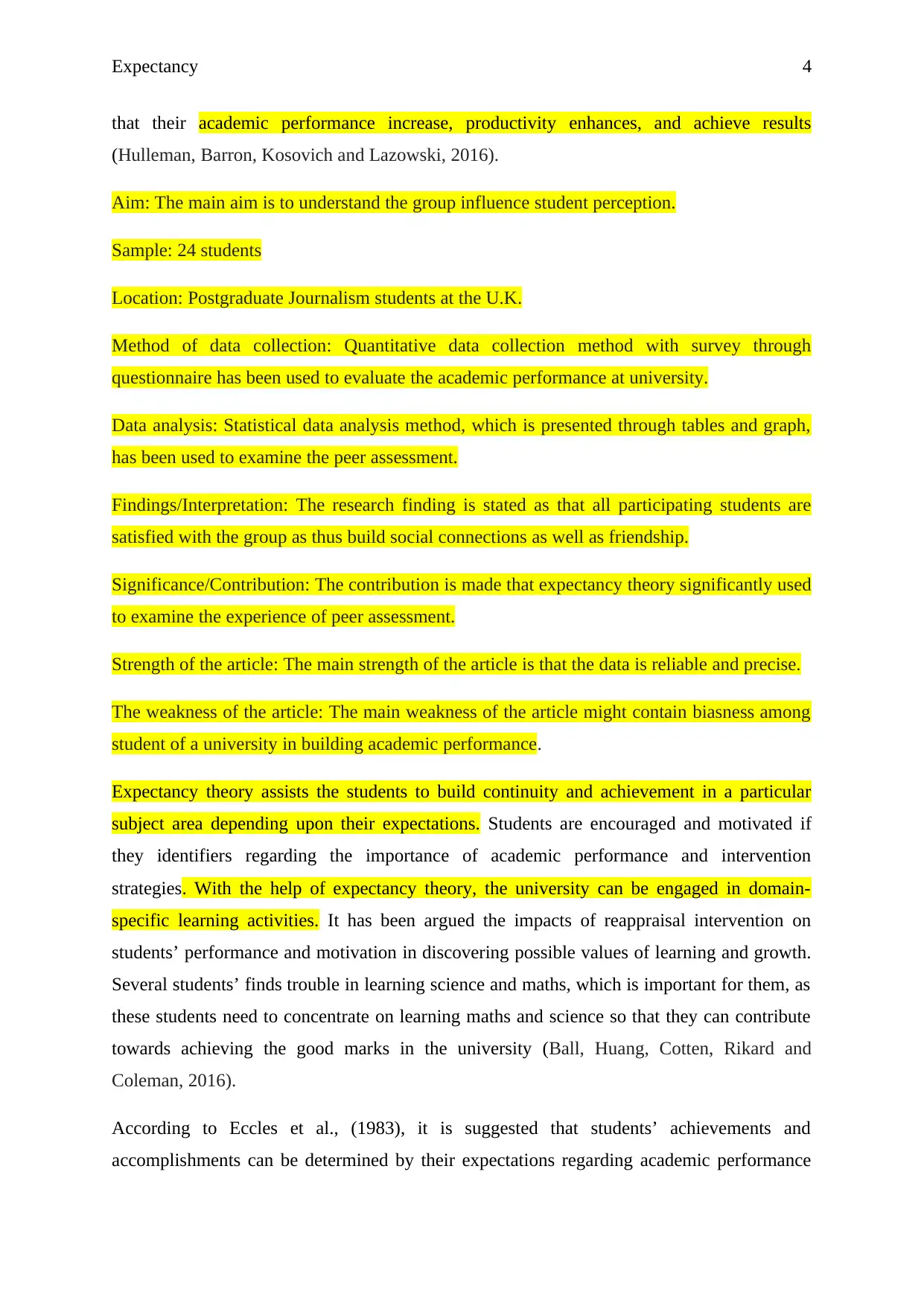
Expectancy 4
that their academic performance increase, productivity enhances, and achieve results
(Hulleman, Barron, Kosovich and Lazowski, 2016).
Aim: The main aim is to understand the group influence student perception.
Sample: 24 students
Location: Postgraduate Journalism students at the U.K.
Method of data collection: Quantitative data collection method with survey through
questionnaire has been used to evaluate the academic performance at university.
Data analysis: Statistical data analysis method, which is presented through tables and graph,
has been used to examine the peer assessment.
Findings/Interpretation: The research finding is stated as that all participating students are
satisfied with the group as thus build social connections as well as friendship.
Significance/Contribution: The contribution is made that expectancy theory significantly used
to examine the experience of peer assessment.
Strength of the article: The main strength of the article is that the data is reliable and precise.
The weakness of the article: The main weakness of the article might contain biasness among
student of a university in building academic performance.
Expectancy theory assists the students to build continuity and achievement in a particular
subject area depending upon their expectations. Students are encouraged and motivated if
they identifiers regarding the importance of academic performance and intervention
strategies. With the help of expectancy theory, the university can be engaged in domain-
specific learning activities. It has been argued the impacts of reappraisal intervention on
students’ performance and motivation in discovering possible values of learning and growth.
Several students’ finds trouble in learning science and maths, which is important for them, as
these students need to concentrate on learning maths and science so that they can contribute
towards achieving the good marks in the university (Ball, Huang, Cotten, Rikard and
Coleman, 2016).
According to Eccles et al., (1983), it is suggested that students’ achievements and
accomplishments can be determined by their expectations regarding academic performance
that their academic performance increase, productivity enhances, and achieve results
(Hulleman, Barron, Kosovich and Lazowski, 2016).
Aim: The main aim is to understand the group influence student perception.
Sample: 24 students
Location: Postgraduate Journalism students at the U.K.
Method of data collection: Quantitative data collection method with survey through
questionnaire has been used to evaluate the academic performance at university.
Data analysis: Statistical data analysis method, which is presented through tables and graph,
has been used to examine the peer assessment.
Findings/Interpretation: The research finding is stated as that all participating students are
satisfied with the group as thus build social connections as well as friendship.
Significance/Contribution: The contribution is made that expectancy theory significantly used
to examine the experience of peer assessment.
Strength of the article: The main strength of the article is that the data is reliable and precise.
The weakness of the article: The main weakness of the article might contain biasness among
student of a university in building academic performance.
Expectancy theory assists the students to build continuity and achievement in a particular
subject area depending upon their expectations. Students are encouraged and motivated if
they identifiers regarding the importance of academic performance and intervention
strategies. With the help of expectancy theory, the university can be engaged in domain-
specific learning activities. It has been argued the impacts of reappraisal intervention on
students’ performance and motivation in discovering possible values of learning and growth.
Several students’ finds trouble in learning science and maths, which is important for them, as
these students need to concentrate on learning maths and science so that they can contribute
towards achieving the good marks in the university (Ball, Huang, Cotten, Rikard and
Coleman, 2016).
According to Eccles et al., (1983), it is suggested that students’ achievements and
accomplishments can be determined by their expectations regarding academic performance
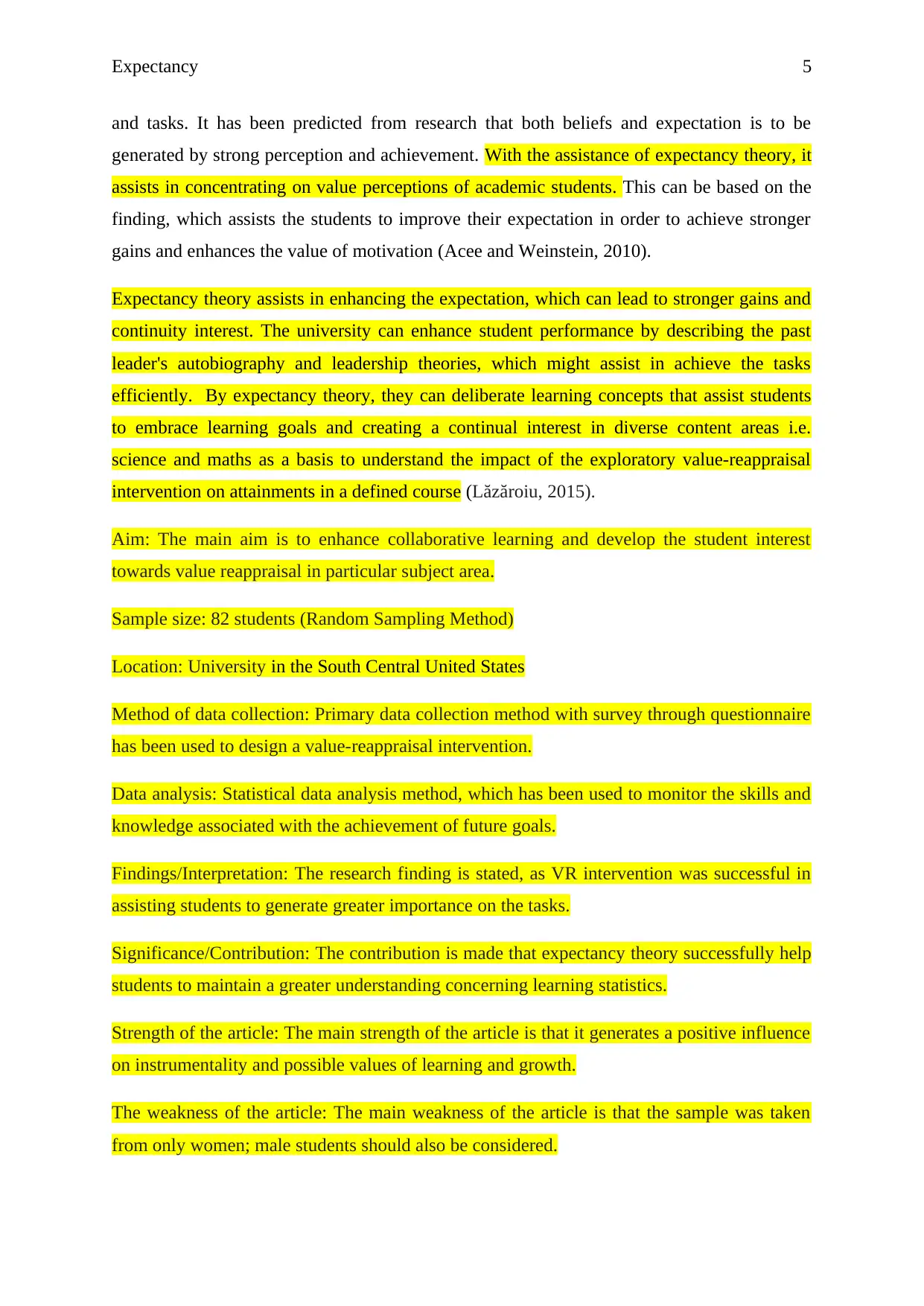
Expectancy 5
and tasks. It has been predicted from research that both beliefs and expectation is to be
generated by strong perception and achievement. With the assistance of expectancy theory, it
assists in concentrating on value perceptions of academic students. This can be based on the
finding, which assists the students to improve their expectation in order to achieve stronger
gains and enhances the value of motivation (Acee and Weinstein, 2010).
Expectancy theory assists in enhancing the expectation, which can lead to stronger gains and
continuity interest. The university can enhance student performance by describing the past
leader's autobiography and leadership theories, which might assist in achieve the tasks
efficiently. By expectancy theory, they can deliberate learning concepts that assist students
to embrace learning goals and creating a continual interest in diverse content areas i.e.
science and maths as a basis to understand the impact of the exploratory value-reappraisal
intervention on attainments in a defined course (Lăzăroiu, 2015).
Aim: The main aim is to enhance collaborative learning and develop the student interest
towards value reappraisal in particular subject area.
Sample size: 82 students (Random Sampling Method)
Location: University in the South Central United States
Method of data collection: Primary data collection method with survey through questionnaire
has been used to design a value-reappraisal intervention.
Data analysis: Statistical data analysis method, which has been used to monitor the skills and
knowledge associated with the achievement of future goals.
Findings/Interpretation: The research finding is stated, as VR intervention was successful in
assisting students to generate greater importance on the tasks.
Significance/Contribution: The contribution is made that expectancy theory successfully help
students to maintain a greater understanding concerning learning statistics.
Strength of the article: The main strength of the article is that it generates a positive influence
on instrumentality and possible values of learning and growth.
The weakness of the article: The main weakness of the article is that the sample was taken
from only women; male students should also be considered.
and tasks. It has been predicted from research that both beliefs and expectation is to be
generated by strong perception and achievement. With the assistance of expectancy theory, it
assists in concentrating on value perceptions of academic students. This can be based on the
finding, which assists the students to improve their expectation in order to achieve stronger
gains and enhances the value of motivation (Acee and Weinstein, 2010).
Expectancy theory assists in enhancing the expectation, which can lead to stronger gains and
continuity interest. The university can enhance student performance by describing the past
leader's autobiography and leadership theories, which might assist in achieve the tasks
efficiently. By expectancy theory, they can deliberate learning concepts that assist students
to embrace learning goals and creating a continual interest in diverse content areas i.e.
science and maths as a basis to understand the impact of the exploratory value-reappraisal
intervention on attainments in a defined course (Lăzăroiu, 2015).
Aim: The main aim is to enhance collaborative learning and develop the student interest
towards value reappraisal in particular subject area.
Sample size: 82 students (Random Sampling Method)
Location: University in the South Central United States
Method of data collection: Primary data collection method with survey through questionnaire
has been used to design a value-reappraisal intervention.
Data analysis: Statistical data analysis method, which has been used to monitor the skills and
knowledge associated with the achievement of future goals.
Findings/Interpretation: The research finding is stated, as VR intervention was successful in
assisting students to generate greater importance on the tasks.
Significance/Contribution: The contribution is made that expectancy theory successfully help
students to maintain a greater understanding concerning learning statistics.
Strength of the article: The main strength of the article is that it generates a positive influence
on instrumentality and possible values of learning and growth.
The weakness of the article: The main weakness of the article is that the sample was taken
from only women; male students should also be considered.
⊘ This is a preview!⊘
Do you want full access?
Subscribe today to unlock all pages.

Trusted by 1+ million students worldwide
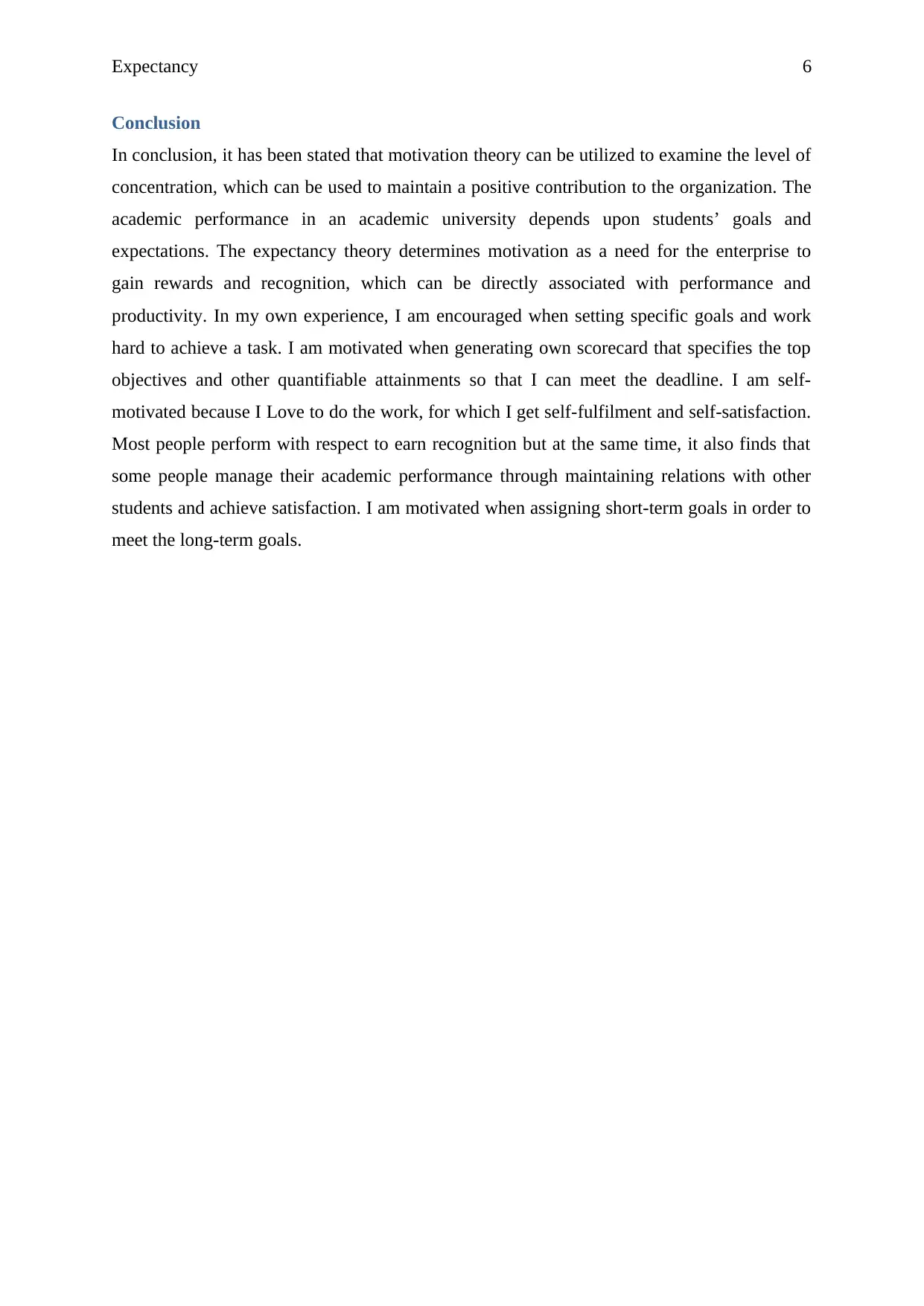
Expectancy 6
Conclusion
In conclusion, it has been stated that motivation theory can be utilized to examine the level of
concentration, which can be used to maintain a positive contribution to the organization. The
academic performance in an academic university depends upon students’ goals and
expectations. The expectancy theory determines motivation as a need for the enterprise to
gain rewards and recognition, which can be directly associated with performance and
productivity. In my own experience, I am encouraged when setting specific goals and work
hard to achieve a task. I am motivated when generating own scorecard that specifies the top
objectives and other quantifiable attainments so that I can meet the deadline. I am self-
motivated because I Love to do the work, for which I get self-fulfilment and self-satisfaction.
Most people perform with respect to earn recognition but at the same time, it also finds that
some people manage their academic performance through maintaining relations with other
students and achieve satisfaction. I am motivated when assigning short-term goals in order to
meet the long-term goals.
Conclusion
In conclusion, it has been stated that motivation theory can be utilized to examine the level of
concentration, which can be used to maintain a positive contribution to the organization. The
academic performance in an academic university depends upon students’ goals and
expectations. The expectancy theory determines motivation as a need for the enterprise to
gain rewards and recognition, which can be directly associated with performance and
productivity. In my own experience, I am encouraged when setting specific goals and work
hard to achieve a task. I am motivated when generating own scorecard that specifies the top
objectives and other quantifiable attainments so that I can meet the deadline. I am self-
motivated because I Love to do the work, for which I get self-fulfilment and self-satisfaction.
Most people perform with respect to earn recognition but at the same time, it also finds that
some people manage their academic performance through maintaining relations with other
students and achieve satisfaction. I am motivated when assigning short-term goals in order to
meet the long-term goals.
Paraphrase This Document
Need a fresh take? Get an instant paraphrase of this document with our AI Paraphraser
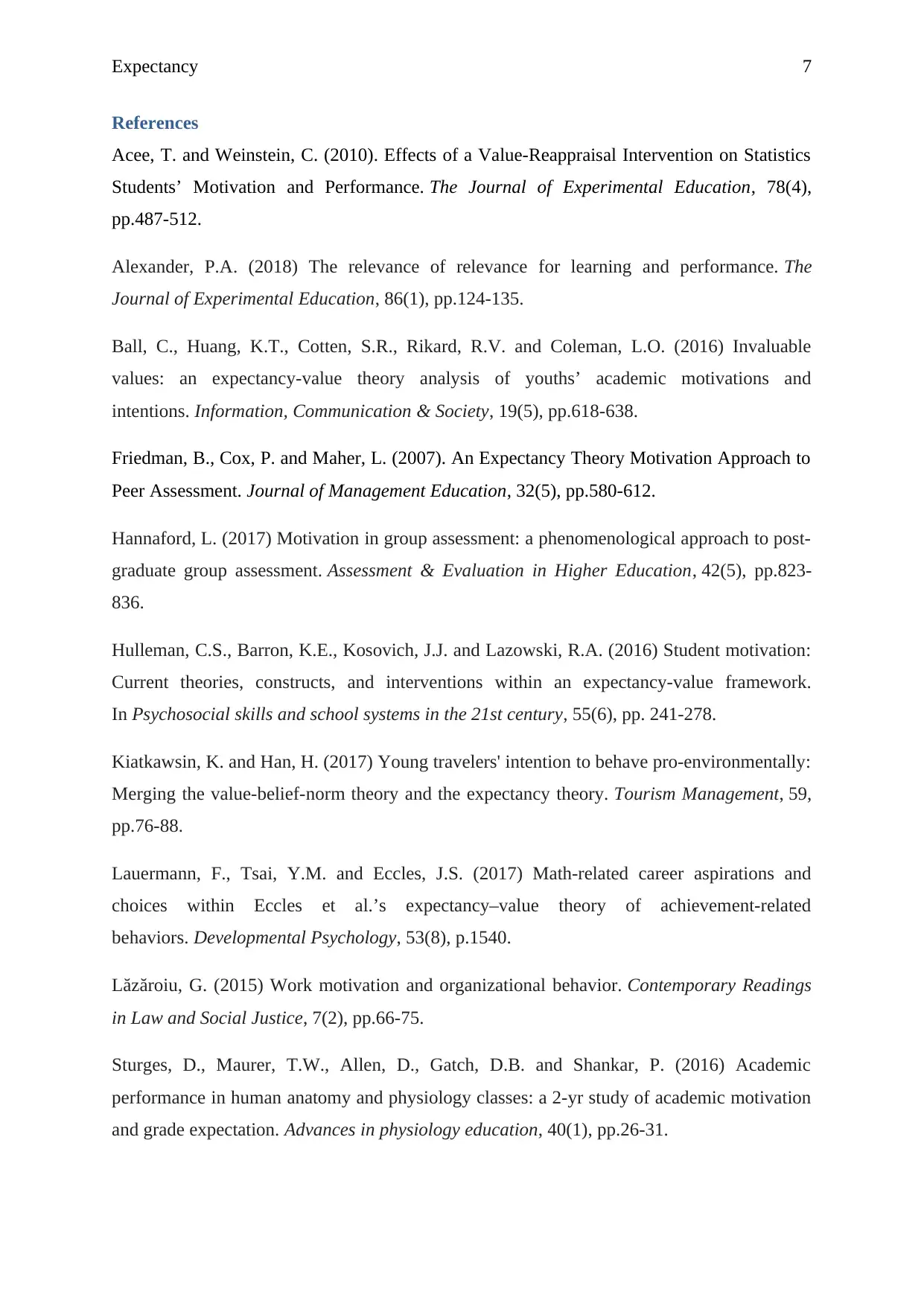
Expectancy 7
References
Acee, T. and Weinstein, C. (2010). Effects of a Value-Reappraisal Intervention on Statistics
Students’ Motivation and Performance. The Journal of Experimental Education, 78(4),
pp.487-512.
Alexander, P.A. (2018) The relevance of relevance for learning and performance. The
Journal of Experimental Education, 86(1), pp.124-135.
Ball, C., Huang, K.T., Cotten, S.R., Rikard, R.V. and Coleman, L.O. (2016) Invaluable
values: an expectancy-value theory analysis of youths’ academic motivations and
intentions. Information, Communication & Society, 19(5), pp.618-638.
Friedman, B., Cox, P. and Maher, L. (2007). An Expectancy Theory Motivation Approach to
Peer Assessment. Journal of Management Education, 32(5), pp.580-612.
Hannaford, L. (2017) Motivation in group assessment: a phenomenological approach to post-
graduate group assessment. Assessment & Evaluation in Higher Education, 42(5), pp.823-
836.
Hulleman, C.S., Barron, K.E., Kosovich, J.J. and Lazowski, R.A. (2016) Student motivation:
Current theories, constructs, and interventions within an expectancy-value framework.
In Psychosocial skills and school systems in the 21st century, 55(6), pp. 241-278.
Kiatkawsin, K. and Han, H. (2017) Young travelers' intention to behave pro-environmentally:
Merging the value-belief-norm theory and the expectancy theory. Tourism Management, 59,
pp.76-88.
Lauermann, F., Tsai, Y.M. and Eccles, J.S. (2017) Math-related career aspirations and
choices within Eccles et al.’s expectancy–value theory of achievement-related
behaviors. Developmental Psychology, 53(8), p.1540.
Lăzăroiu, G. (2015) Work motivation and organizational behavior. Contemporary Readings
in Law and Social Justice, 7(2), pp.66-75.
Sturges, D., Maurer, T.W., Allen, D., Gatch, D.B. and Shankar, P. (2016) Academic
performance in human anatomy and physiology classes: a 2-yr study of academic motivation
and grade expectation. Advances in physiology education, 40(1), pp.26-31.
References
Acee, T. and Weinstein, C. (2010). Effects of a Value-Reappraisal Intervention on Statistics
Students’ Motivation and Performance. The Journal of Experimental Education, 78(4),
pp.487-512.
Alexander, P.A. (2018) The relevance of relevance for learning and performance. The
Journal of Experimental Education, 86(1), pp.124-135.
Ball, C., Huang, K.T., Cotten, S.R., Rikard, R.V. and Coleman, L.O. (2016) Invaluable
values: an expectancy-value theory analysis of youths’ academic motivations and
intentions. Information, Communication & Society, 19(5), pp.618-638.
Friedman, B., Cox, P. and Maher, L. (2007). An Expectancy Theory Motivation Approach to
Peer Assessment. Journal of Management Education, 32(5), pp.580-612.
Hannaford, L. (2017) Motivation in group assessment: a phenomenological approach to post-
graduate group assessment. Assessment & Evaluation in Higher Education, 42(5), pp.823-
836.
Hulleman, C.S., Barron, K.E., Kosovich, J.J. and Lazowski, R.A. (2016) Student motivation:
Current theories, constructs, and interventions within an expectancy-value framework.
In Psychosocial skills and school systems in the 21st century, 55(6), pp. 241-278.
Kiatkawsin, K. and Han, H. (2017) Young travelers' intention to behave pro-environmentally:
Merging the value-belief-norm theory and the expectancy theory. Tourism Management, 59,
pp.76-88.
Lauermann, F., Tsai, Y.M. and Eccles, J.S. (2017) Math-related career aspirations and
choices within Eccles et al.’s expectancy–value theory of achievement-related
behaviors. Developmental Psychology, 53(8), p.1540.
Lăzăroiu, G. (2015) Work motivation and organizational behavior. Contemporary Readings
in Law and Social Justice, 7(2), pp.66-75.
Sturges, D., Maurer, T.W., Allen, D., Gatch, D.B. and Shankar, P. (2016) Academic
performance in human anatomy and physiology classes: a 2-yr study of academic motivation
and grade expectation. Advances in physiology education, 40(1), pp.26-31.
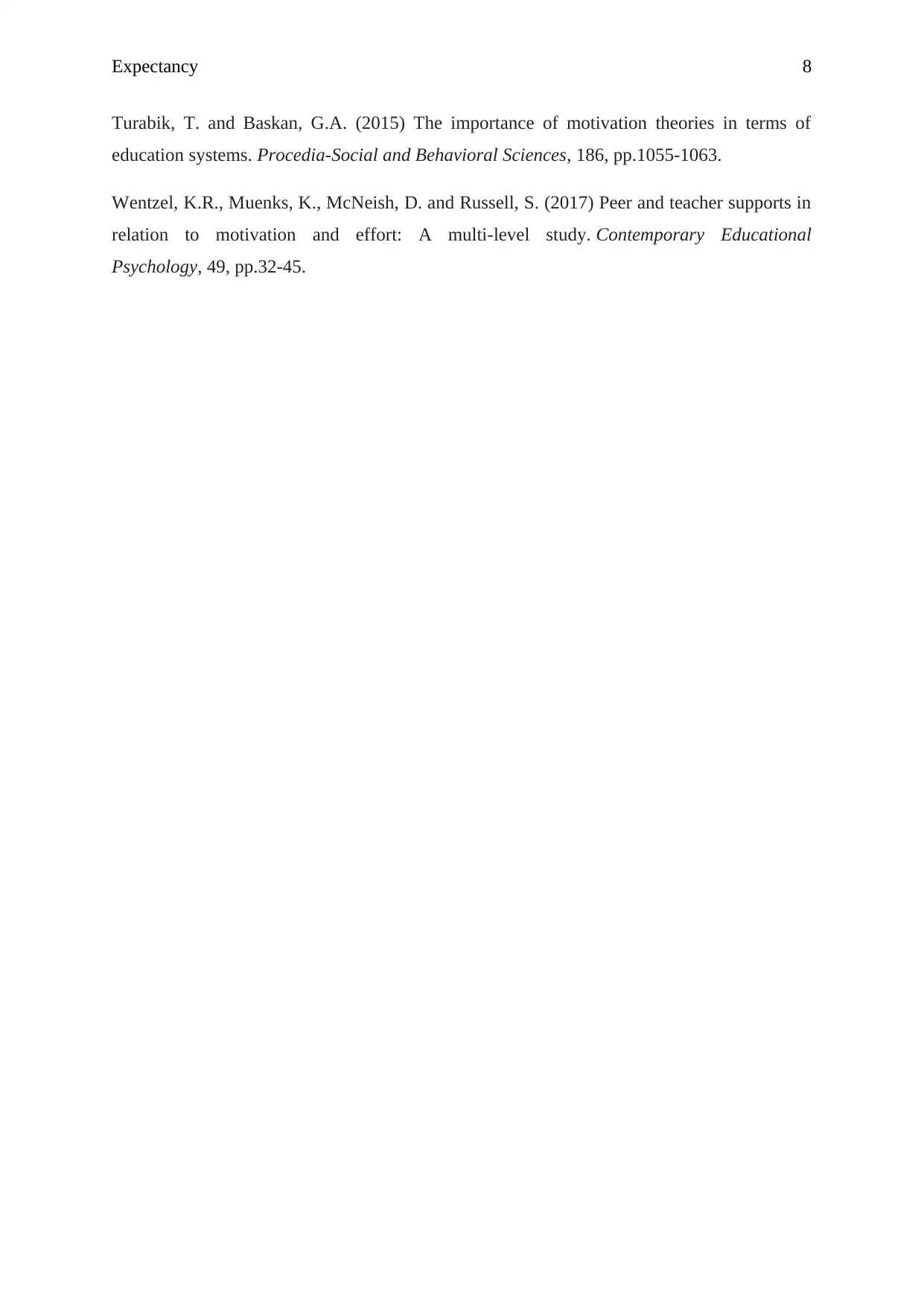
Expectancy 8
Turabik, T. and Baskan, G.A. (2015) The importance of motivation theories in terms of
education systems. Procedia-Social and Behavioral Sciences, 186, pp.1055-1063.
Wentzel, K.R., Muenks, K., McNeish, D. and Russell, S. (2017) Peer and teacher supports in
relation to motivation and effort: A multi-level study. Contemporary Educational
Psychology, 49, pp.32-45.
Turabik, T. and Baskan, G.A. (2015) The importance of motivation theories in terms of
education systems. Procedia-Social and Behavioral Sciences, 186, pp.1055-1063.
Wentzel, K.R., Muenks, K., McNeish, D. and Russell, S. (2017) Peer and teacher supports in
relation to motivation and effort: A multi-level study. Contemporary Educational
Psychology, 49, pp.32-45.
⊘ This is a preview!⊘
Do you want full access?
Subscribe today to unlock all pages.

Trusted by 1+ million students worldwide
1 out of 9
Related Documents
Your All-in-One AI-Powered Toolkit for Academic Success.
+13062052269
info@desklib.com
Available 24*7 on WhatsApp / Email
![[object Object]](/_next/static/media/star-bottom.7253800d.svg)
Unlock your academic potential
Copyright © 2020–2025 A2Z Services. All Rights Reserved. Developed and managed by ZUCOL.





